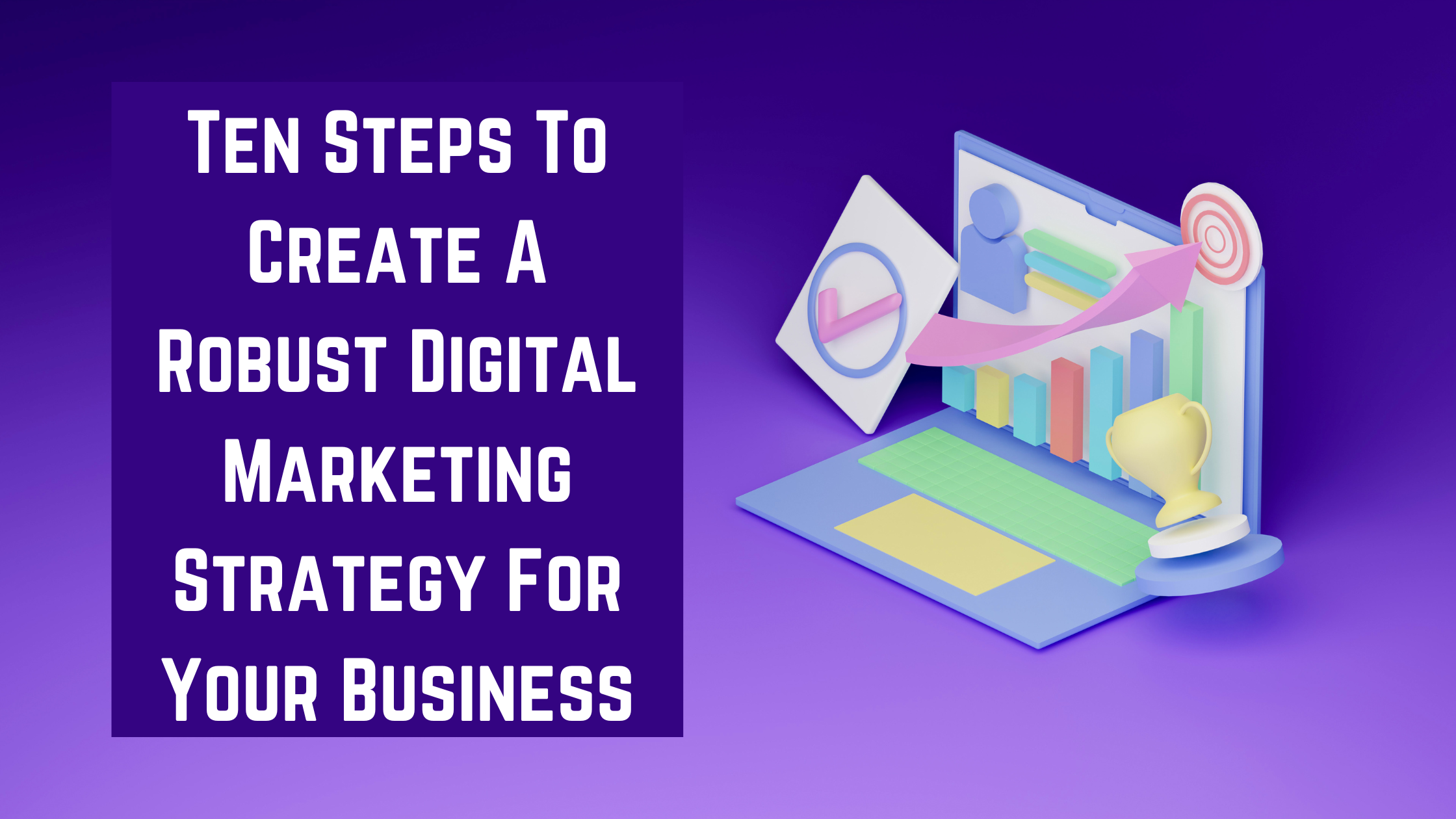Table of Contents
Are you struggling with thinking strategically for your business’s digital marketing solutions? We are the best digital marketing agency in Faridabad eager to simplify this process for you.
10 Steps To Developing An Effective Digital Marketing Strategy For Your Business
Developing a digital marketing strategy for your business requires careful planning and consideration of various factors.
Here’s a step-by-step guide to help you create an effective digital marketing strategy:
Step 1: Set Clear Goals:
Start by defining your business objectives and what you want to achieve with your digital marketing efforts. Your goals could include increasing brand awareness, driving website traffic, generating leads, or boosting online sales. That said, your goals must be Specific, Measurable, Attainable, Relevant, and Time-bound (SMART goals).
Step 2: Know Your Target Audience:
Identify your target audience by creating buyer personas. Understand their interests, online behavior, demographics, and preferences. This information will help you tailor your marketing messages and choose the most suitable digital channels to reach your audience effectively.
Step 3: Conduct Competitor Research:
Analyze your competitors’ digital presence and marketing strategies. Check what their strengths, weaknesses, and unique selling points convey regarding their brand. This research will help you identify gaps in the market and differentiate your business from competitors.
Step 4: Choose The Right Digital Channels:
Determine which digital marketing channels are most suitable for your business and target audience. Options may include search engine optimization (SEO), social media marketing, content marketing, email marketing, pay-per-click (PPC) advertising, influencer marketing, and more. Consider the channels that align with your goals, budget, and audience preferences.

Step 5: Develop Engaging Content:
Content is the backbone of digital marketing. Create high-quality, relevant, and engaging content that resonates with your target audience. This can include blog posts, articles, videos, infographics, podcasts, and social media content. Tailor your content to each digital channel and optimize it for search engines to increase visibility.
Step 6: Optimise For Search Engines:
Implement SEO techniques to improve your website’s visibility on search engines. Carry out comprehensive keyword research to identify
relevant keywords. Furthermore, integrate selected focus and secondary keywords naturally into your website content. Optimize your URLs, meta tags, headings, and image alt tags. You can then build high-quality backlinks from reputable websites. This will help improve the search rankings of your brand’s website.
Step 7: Implement Social Media Strategies:
Leverage social media platforms to build brand awareness, engage with your audience, and drive website traffic. Choose the platforms where your target audience is most active and develop a content strategy that aligns with each platform’s unique features. Engage with your followers, respond to comments and messages, and run targeted ad campaigns to reach a wider audience.
Step 8: Utilise Email Marketing:
Build an email list of interested prospects and customers. Segment your list based on demographics, preferences, or past interactions. Send personalized, targeted email campaigns to nurture leads, promote products or services, and drive conversions. Provide valuable content, exclusive offers, and incentives to encourage engagement and maintain a strong relationship with your subscribers.
Step 9: Monitor and Analyze Results:
Track the performance of your digital marketing campaigns using web analytics tools like Google Analytics. Monitor key metrics such as website traffic, conversions, click-through rates, engagement rates, and social media metrics. Check and study the data to understand what works, what doesn’t, and what needs improvement. Work around your strategy based on these insights to improve your results.
Step 10: Stay Updated And Evolve:
The digital marketing landscape is constantly evolving. Commit to an ongoing check on the latest trends, best practices, and technologies, in the market to integrate them into your strategy over time. Experiment with new strategies, test different approaches, and adapt your digital marketing strategy accordingly to stay ahead of the competition.
Remember, developing an effective digital marketing strategy takes time and continuous effort. Regularly evaluate your results, make data-driven decisions, and refine your approach to achieve your business objectives.

Related Blogs
- Why Digital Marketing Is Important For Small Businesses?
- Digital Transformation: How Technology Is Revolutionizing Marketing
- Transform Your Brand’s Image With These Digital Marketing Trends In 2023
- 10 Digital Marketing Strategies For B2B Businesses
- Everything You Need To Know About Creating A Business Profile That Generates Leads.
- Generate Leads Through Paid Marketing Techniques
- The Complete Guide To Building Your Personal Brand
- Branding Vs Marketing Vs Sales
- Why Marketing Strategy is Important
- Why Is Branding Important
- What are Business Goals? Step-by-Step Guide






Pingback: Why Digital Marketing Is Important For Small Business
Pingback: Generate Leads Through Paid Marketing Techniques - Digitalz Pro Media & Technologies (P) Ltd
Pingback: Branding Vs Marketing Vs Sales - Digitalz Pro Media & Technologies (P) Ltd
Pingback: Why Is Branding Important - Digitalz Pro Media & Technologies (P) Ltd
Pingback: What are Business Goals? Step by Step Guide - Digitalz Pro Media & Technologies (P) Ltd
Pingback: Digital Transformation: How Technology Is Revolutionizing Marketing
Pingback: Digital Marketing Trends In 2023 - Digitalz Pro Media & Technologies (P) Ltd
Pingback: Why Marketing Strategy is Important - Digitalz Pro Media & Technologies (P) Ltd
Pingback: The Complete Guide To Building Your Personal Brand - Digitalz Pro Media & Technologies (P) Ltd